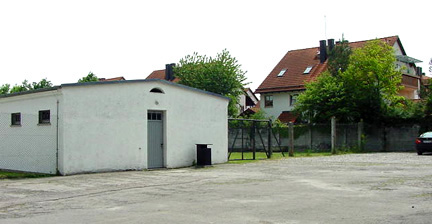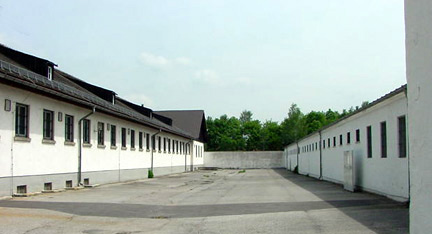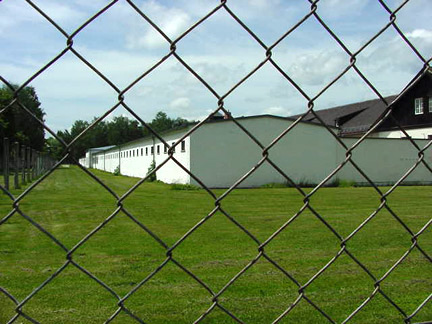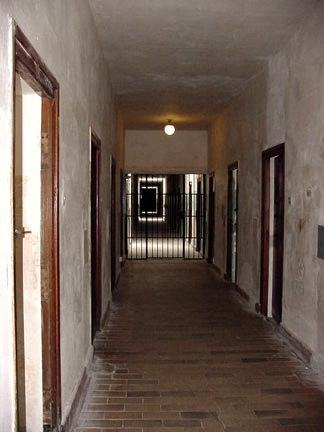The Bunker at Dachau Concentration Camp On January 27, 2000, a new exhibit in the former bunker (camp prison) at Dachau was formally dedicated in an opening ceremony attended by several of the former inmates. The exhibit was commissioned by the Bavarian Council of Ministers and set up by the Center for Bavarian History. It was designed by Johannes Segieth. The bunker has been open to visitors since 1998. After the Dachau concentration camp was opened on March 22, 1933, a small camp prison with only 5 cells was set up a month later in one of the old buildings of the gun powder and munitions factory, where the camp was located. The camp prison, called the Lagerarrest, was moved to a new location in 1934. This new prison had 22 cells and resembled a bunker, which was the origin of the nickname. When the Dachau camp was rebuilt by the prisoners in a construction project from 1937 to 1938, a new prison with 137 cells was added behind the service building.  The bunker was used from 1938 to 1945 to incarcerate high-level "enemies of the state," such as Sepp Götz, a Communist member of the German parliament, who died in the bunker. In 1941, several cells at the west end were set aside for Ehrenhäftlinge. These "honor prisoners" were high-ranking clergymen or important political prisoners. They did not have to work and were not subject to punishments. Their cells were left unlocked.  The west end of the long bunker building is shown on the left in the photograph above. To the right of the bunker is a narrow courtyard with grass where the privileged prisoners who lived in the bunker could walk around or receive visitors. Behind the courtyard is a wall and just beyond the wall are new houses, built in the 1990ies, which are on Pater-Roth-Strasse, the street where Bus number 726 stops. The broad street in front of the bunker goes past the Jourhaus a few yards to the north. This street was used as the place where prisoners had to stand for long periods in the "standing punishment." This punishment was discontinued in 1942 when it was banned by Commandant Martin Gottfried Weiss. At the very end of this long street is the tourist entrance to the crematoria area where the gas chambers are located. The bunker is a very long building, located just south of the service building which now houses the Museum. In the photograph below, the service building is on the left and the bunker is on the right.  At the end of the courtyard between the buildings in the photo above, prisoners were executed by hanging. The prison cells in the bunker are on both sides of a hallway which runs the length of the building. Each cell has an outside window which overlooks one of the two courtyards on either side. "Honor prisoners" such as the Rev. Martin Niemöller and Dr. Johannes Neuhäusler did not have to remain in their cells in the daytime, but could walk around outside. The Rev. Niemöller's name is familiar to most Americans because of this famous quote. In 1941, a new block was built at right angles to the east end of the bunker; it was set aside for camp guards in any of the camps who had broken the strict rules of the SS. The SS prison wing has since been torn down. The SS men were held to very high standards and any loutish behavior was punished. In April 1945, there were 128 German SS soldiers imprisoned in the Dachau bunker, according to Paul Berben, a prisoner in the camp who wrote the Official History of the camp. On April 28, 1945 when the other guards left the camp, the SS men in the bunker were released and ordered to remain behind to guard the camp until it could be surrendered to the Americans. At least some of them were probably among the soldiers who were killed by the Americans or beaten to death by the prisoners after the camp was liberated. Police officers and air raid wardens who failed in their duties were also imprisoned in this section of the bunker. There is no mention of the former SS prison at Dachau, as this is a Memorial Site devoted to the victims, not the perpetrators. After the war, German war criminals were imprisoned in the Dachau bunker during the war crimes trials which took place at Dachau, but this is not mentioned in the exhibit. One of the war criminals, Gustav Petrat, who was tried and convicted at Dachau, described his treatment in the bunker, at the hands of the American prosecutors, in his final statement to the court after he was sentenced to death. In Appendix A of The Official Report by the US Seventh Army, written in the first few days after the liberation of the camp, a "Special Case Report" is given regarding Waffen-SS officer Gerhard Wiebeck. The report stated as follows: "Wiebeck, Gerhard - Subject is an SS judge holding the rank of SS Obersturmführer. Subject is a lawyer by profession and in this capacity secured employment with the State Police in Berlin, where he remained until 1940. In 1939, he attained the rank of Untersturnführer in the Allgemeine SS because of his position on the Help Crimes Commission. In February 1940, Wiebeck was transferred to Waffen SS as a soldier in Prague, and became an SS judge in November 1943. As an SS judge, subject was charged with investigation of all crimes committed by SS men and from this point of view has much information to offer concerning SS men." The photograph below shows the east end of the bunker building. The former wing where SS soldiers who had committed a crime were imprisoned has been torn down. Although not visible in the photograph, visitors can see that the former door into the SS wing of the prison has been closed up.  As shown in the photograph below, the hallway in the bunker is not dark as it has both electric lights and skylights. Notice the three patches of white which indicate a skylight in that location. The second photograph below shows one of the cell doors with sunlight coming through one of the skylights. Notice that the hall floor is covered with the same kind of brick that was used in the homicidal gas chamber in the crematorium at Dachau.  Visitors are not allowed to go inside the cells, but some of the cells have open doors so that one can see inside. Three of the cells have quotations by the former inmates projected on the wall so that visitors can read their words. Cell number 30 was where the Rev. Niemöller was imprisoned from July 1941 to April 1945. In a nearby cell, Dr. Johannes Neuhäusler was also a prisoner between July 1941 and April 1945. Prior to July 1941, both were prisoners at Sachsenhausen, where Rudolf Höss was an adjutant. Höss was later transferred to Auschwitz where he was responsible for the gassing of millions of Jews, according to his confession. In his memoirs, Höss wrote about the extraordinarily good treatment that the Rev. Niemöller had received at Sachsenhausen and said that he was treated even better at Dachau. Cell number 73 was where Dr. Sigmund Rascher was shot in the back of the head, allegedly on orders from Reichsführer Heinrich Himmler, on April 26, 1945, three days before the camp was liberated. This was the same day that other "special prisoners" were either released or sent to the South Tyrol. Dr. Rascher was the doctor who performed medical experiments on Dachau prisoners for the benefit of the German Air Force. Dr. Rascher was imprisoned by the Nazis because he had allegedly violated the law by taking orphaned children into his home and falsely claiming that they were his own children. Dr. Rascher had initially been held in a prison in Munich, and had been transferred as a "special prisoner" to Dachau in April 1945. Exhibits in the bunkerBack to Dachau Concentration CampBack to Table of ContentsHomeThis page was updated on May 23, 2009 |